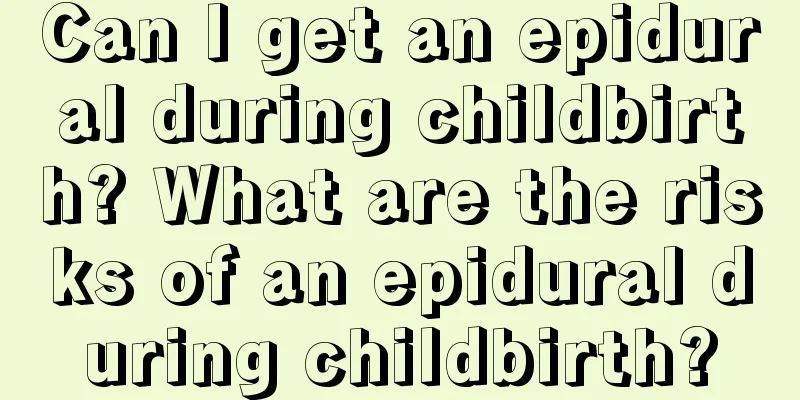When does the baby's umbilical cord fall off? How to care for the baby after the umbilical cord falls off?

|
The umbilical cord is the bond that connects the mother and the baby when the baby is in the mother's belly. So after birth, when will the cut umbilical cord fall off? How to care for the baby's umbilical cord after it falls off? Let's learn together~ For young parents, the first month after the birth of a child can be called the "new parent period". Parents should quickly familiarize themselves with the physiological characteristics of newborn babies, learn scientific knowledge about caring for newborn babies, and help the delicate little lives through the "dangerous period". When does a newborn baby's umbilical cord fall off?The navel is the only way for the mother to supply nutrition to the fetus and for the fetus to excrete waste. Under normal circumstances, the umbilical cord naturally shrivels up 24 to 48 hours after birth, begins to fall off in 3 to 4 days, and heals on its own in 10 to 15 days. After the umbilical cord of a newborn baby is tied, the blood vessels in the umbilical pit have not completely closed, and the umbilical pit is prone to water accumulation and is not easy to dry. Therefore, it is easy for bacteria to breed and cause infection, and even sepsis in severe cases. Therefore, mothers should check the navel of newborn babies every day, keep the navel clean and dry, and avoid urine and feces contamination; keep the navel dry before the umbilical cord falls off, and do not take a full body bath; wipe the base of the navel with a 75% alcohol cotton swab every day. After the umbilical cord falls off, there may still be secretions in the navel pit, and alcohol disinfection is still required at this time. If there is a scab, the scab should be removed and the bottom should be thoroughly cleaned. Do not apply prickly heat powder to the navel casually to avoid infection. If you find any symptoms of infection, you must see a doctor in time. How to care for the umbilical cord of a newbornAfter understanding the principles of umbilical cord care, mothers should do a good job of umbilical cord care for their babies. This care work should be divided into two stages. Simply put, there are two stages of change: before the umbilical cord falls off and after it falls off. Stage 1: Before the umbilical cord falls off After the umbilical cord is cut, a wound is formed, which is an important portal for bacteria to invade the newborn's body. In mild cases, it can cause omphalitis, and in severe cases, it often leads to sepsis and death. Therefore, disinfection and care of the umbilical cord are very important. Generally, 24 hours after the baby is born, the gauze bandage should be opened and no longer bandaged to promote the drying and shedding of the umbilical cord stump. When handling the umbilical cord, wash your hands and pinch the umbilical cord, lift it gently, and use a 75% disinfectant alcohol cotton swab to disinfect the root of the umbilical cord, wipe off all secretions and blood stains, 1 to 2 times a day, to keep the root of the umbilical cord clean. At the same time, diapers must be changed frequently to avoid urine and feces from contaminating the umbilical cord. Before the umbilical cord falls off, the area should be kept clean and dry, especially the diaper should not cover the navel to prevent the navel wound from getting wet after urination. Check the gauze bandage for bleeding frequently. If bleeding occurs, it needs to be re-ligated to stop bleeding. If there is no bleeding, just wipe the base of the umbilical cord with a 75% alcohol cotton swab every day and wait for it to fall off naturally. How to use baby umbilical cord stickers Stage 2: After the umbilical cord falls off After the umbilical cord falls off, there is often a small amount of exudate in the navel. At this time, you can use a 75% alcohol cotton swab to clean the navel, and then cover it with sterilized gauze. It is recommended to use a sponge bath for newborn babies whose umbilical cords have just fallen off, and do not wet the navel. The baby should not go into the water. The mother should wring the gauze half dry and gently wipe the baby's body. After the wound is completely healed, you can take a water bath, but you don't put the baby directly into the water. Instead, put a bath bed on the bathtub and let the baby sleep on it to wash. When the baby can sit at 5 or 6 months old, you can put the baby directly in the water to wash. In addition, there are some specific details that must be paid attention to when caring for a newborn's umbilical cord. 1. Mothers must wash their hands when caring for the umbilical cord area to prevent bacteria on their hands from infecting the baby's navel. 2. When bathing your baby, do not let the umbilical cord get wet before it falls off. If you let your baby swim during the newborn stage, be sure to apply a waterproof sticker. 3. Never use gentian violet. Some babies' belly buttons do not fall off for a long time, or pus forms after falling off. Some elderly people use gentian violet to wipe the baby's umbilical cord in order to dry it. This method was often used in the past, but it is not recommended in medicine now because the drying effect of gentian violet is limited to the surface, while the drying effect of iodine tincture dries from the inside out. 4. Within 24 hours after the umbilical cord is tied, parents should closely observe whether there is any bleeding. Some newborn babies may have a small amount of exudate or bleeding due to the loosening of the umbilical cord tie. If the gauze covering the umbilical cord is found to be contaminated or soaked with blood, you should immediately ask the doctor to disinfect and re-tie it. 5. Use iodine cotton swab to wipe twice a day, once in the morning and once in the evening. When wiping, lift the small string at the ligation site of the umbilical cord with one hand, and use the cotton swab dipped in iodine to fully wipe the place where the umbilical cord connects to the flesh with the other hand. Wrap it with sterile gauze. Change the dressing regularly in the future. If the cotton swab is dirty, it should be replaced in time. Do not use the dirty cotton swab to wipe repeatedly, as this will cause infection and inflammation. 6. But be careful not to sprinkle "anti-inflammatory powder" on the navel to prevent infection. If there is purulent secretion in the navel, the surrounding skin is red, swollen, hot, and the child has anorexia, vomiting, fever or body temperature does not rise (rectal temperature is less than 35 degrees Celsius), it indicates omphalitis and should be treated in the hospital immediately. How to protect the navel when bathing a newborn babyThe wound after the umbilical cord is cut is the gateway for bacteria to invade. Before the baby's umbilical cord falls off and heals, mothers should take good care of the baby and never let the baby's umbilical cord touch water. Keeping the umbilical cord dry is the most important and basic protective measure. But when you bathe your baby, he will inevitably come into contact with water. How can you protect the belly button that has not fallen off from the water? For newborns whose umbilical cords have not fallen off, the abdomen should not be immersed in water directly to avoid contamination of the navel and infection. Mothers can wring out half-dry gauze and gently wipe the baby's body. If you really have to go into the water, a belly button sticker will come in handy. Before going into the water, stick a belly button sticker on the baby's belly button, close to the skin and drain it tightly. After ensuring that no water will enter, put the baby in the bathtub to wash the body. After taking a bath, remove it after drying the body. After the wound is completely healed, you can bathe the baby in water, but you don't put the baby directly into the water. Instead, put a bath bed on the bathtub and let the baby sleep on it. When the baby is 5 or 6 months old and can sit, you can put the baby directly in the water for a bath. At the same time, in order to prevent the baby's urine from soaking the navel, the mother should change the baby's diaper frequently. If the baby's navel gets wet, it should be immediately blotted dry with cotton cloth, and talcum powder should never be sprinkled around the navel. |
<<: What foods can’t be eaten when breastfeeding? Dietary considerations for breastfeeding mothers
Recommend
What factors will affect your baby's vision? 8 factors to pay attention to
Eyes are the windows to the soul and need our goo...
What does it mean to create a file for pregnant women? What procedures are required for creating a file for pregnant women?
After a pregnant woman becomes pregnant, she will...
Is it good to have confinement during the Spring Festival? What should you pay attention to during the Spring Festival?
The Spring Festival is very special for Chinese p...
What is the reason for the smell of lochia during normal delivery? What should I do if the lochia during normal delivery has a bad smell?
Natural birth is the healthiest way of childbirth...
What are the causes of headaches in children? The most common one is actually the third one
Headache is a common phenomenon, and many people ...
What causes itchy stretch marks? What should I do if they cause itchy stretch marks?
What causes itchy stretch marks? Itchy stretch ma...
What are the symptoms of premature labor?
There are many situations that women may encounte...
What are the situations in which vaginal delivery will be changed to cesarean section? 4 reasons for vaginal delivery to cesarean
The first reason is that the mother is too old. N...
What is progesterone? Is progesterone the same as progesterone?
In the early stages of pregnancy, pregnant mother...
What is the cause of baby phimosis? Foreskin is normal before 3 years old
Does a boy's foreskin need to be pushed back?...
How to judge whether the baby has indigestion? What food is good for the baby to eat?
To determine whether your baby has indigestion, s...
The best time to wean babies The best way to wean babies
After birth, babies mainly drink breast milk from...
Can children with anemia eat donkey-hide gelatin? How to choose milk powder for children with anemia
Anemia in young children is a common phenomenon n...
Can patients with asthenospermia do IVF? Can patients with asthenospermia undergo artificial insemination?
Many men with asthenozoospermia have been unable ...
When is the best time to remove a baby's birthmark?
When is the best time to remove a baby's birt...









